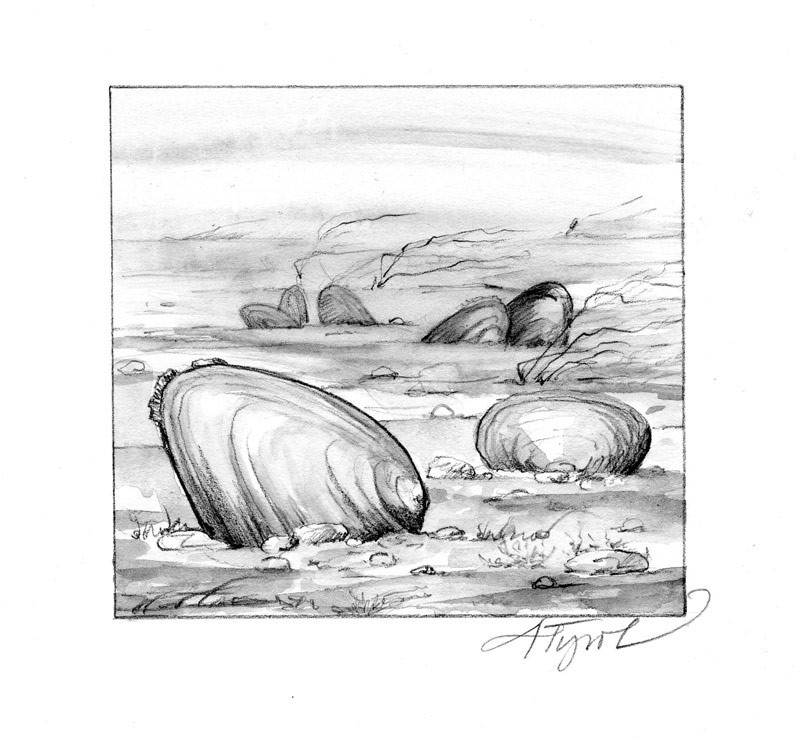
When Andy Warhol said everyone would have 15 minutes of fame, he wasn’t talking about invertebrates. But in March of 1987 the dwarf wedge mussel garnered national attention when Plainfield, N.H., adopted it as the “town mollusk.” Plainfield’s stretch of the Connecticut River harbors one of the last remaining populations of this rare bivalve.
The diminutive mussel may not be as spectacular as other endangered species, such as the Canada lynx or the timber rattlesnake, but it has endeared itself to Plainfield’s residents. Nancy Mogielnicki, a physician’s assistant and one of the community’s chief mussel advocates, jokingly suggested 12 years ago that the town designate its critical habitat as “Mussel Beach.” Mogielnicki reports now that all is quiet on the mussel front: No recent publicity efforts have been launched as the mussels continue their filter-feeding ways. Yet their future remains uncertain.
Viable populations of dwarf wedge mussels are only found in about 20 places in their natural habitat on the East Coast. These spots include locations on the Ashuelot and Connecticut Rivers in New Hampshire and Vermont, and stretches of rivers in Maryland, Connecticut, Massachusetts, New York, New Jersey, Pennsylvania, Virginia and North Carolina. The mussel is listed as endangered by the states of Vermont and New Hampshire and by the federal government.
The mussel, which lives in roiling water below rapids and waterfalls, is threatened by various changes to its habitat. The species needs clean, well-oxygenated, swift-moving water; it has difficulty adapting to both periodic and long-term changes in water temperature and flow. Its populations began ebbing in the late 18th-century, with the advent of dam construction along many of the region’s rivers.
But the mussel still lives in Sumner’s Falls rapids stretching between Plainfield and Hartland, Vt., because the river’s flow there has remained relatively unaltered. It also is found in the Connecticut between Charlestown, N.H., and Springfield, Vt., and between Lancaster, N.H., and Lunenberg, Vt. In addition, it recently has been found in scattered locations from Haverhill/Newbury to Orford/Fairlee, according to the U.S. Fish and Wildlife Service.
The 2-inch-long, greenish-brown, iridescent mussels anchor in beds along the river bottom in depths of a few inches to more than 6 feet. They feed by filtering, plankton, bacteria and plant particles that flow in the current. In July, males release sperm into the water, which females take in to fertilize eggs sheltered in their gills. The fertilized eggs remain in the gills over the winter and develop into larvae, called veligers.
When veligers are released in April or May, they must spend their first days attached to the fins of a fish. Michael Marchand, a wildlife biologist for New Hampshire’s Nongame & Endangered Species Program, reports that Atlantic salmon and two small bottom-feeders—the slimy sculpin and common tessellated darter—often serve as host fish. Over several weeks the larvae grow into small versions of adults and drop off the fish to live on the river bottom. Since adult mussels move about very little, these juvenile hitchhikers help the species to disperse into new territory within their habitat.
Dams are a problem in that they slow water flow upstream, allowing sediments to more readily settle to the bottom, clogging the mussels’ gills and covering what might otherwise be the well-oxygenated and flushed beds of sand, silt and gravel on which mussels thrive. Slow-moving water upstream of the dam usually is warmer, so it contains oxygen at levels too low for the mussels. Riverbank erosion only exacerbates the sedimentation problem.
The dwarf wedge mussel also is threatened by pollution, in the form of toxic chemicals and nutrient runoff, and by the decline in populations of some of the fish species that serve as hosts for their larvae.
Dwarf wedge mussels have a low profile, but their populations are of interest to water biologists—who consider them under-water versions canaries in the coalmines. Because the mollusk is so sensitive to environmental changes, any drop in their population in a particular area can signal possible changes in water quality. The mussel also serves as a biological barometer in helping to safeguard other mussel species in the Connecticut, among them a close relative, the brook floater mussel.
The fate of the dwarf wedge mussel mirrors that of freshwater mussels found throughout North America, where 20 species have been extirpated and roughly 100 are endangered. In fact, nearly half of the continent’s species of freshwater mussels have now become extinct or are on the brink, making this one of our most rapidly disappearing group of animals.

